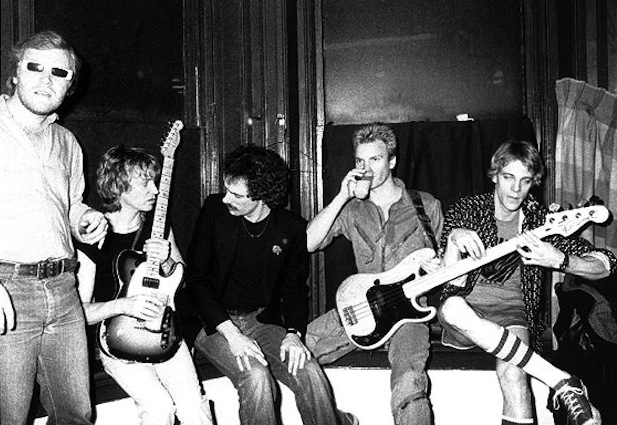The Police hang at The Edge in 1979 with Q107′s Gary Slaight (left) and Brian Master (third from left). Photo courtesy of Gary Topp.
Article originally published November 2, 2012 by The Grid online (thegridto.com).
After punk exploded in the late ’70s, this infamous Gerrard Street new-wave mecca kept the fire burning into the ’80s—even if its many famous performers were in danger of getting doused by the overflowing upstairs toilets leaking onto the stage.
BY: DENISE BENSON
Club: The Edge, 70 Gerrard St. E.
Years in operation: 1979-1981
History: On the northeast corner of Gerrard and Church sits a modest three-floor building that has had—and housed—many lives. It is said to have once been the residence of Egerton (pronounced “Edge-erton”) Ryerson, a prominent Canadian educator who, in 1852, founded the Toronto Normal School at what is now Bond and Gould streets.
Ryerson University is named after him, as was Egerton’s Restaurant and Tavern, a student hangout and folk-music club that opened at 70 Gerrard St. E. in the early 1970s. Licensed as a “listening room” and required to sell food, Egerton’s was open seven days a week, sold cheap beer, and booked live performers like Stan Rogers.
“We lived in the shadow of The Riverboat [in Yorkville] and bigger clubs that had bigger stages and dance floors, like the El Mocambo, Midwich Cuckoo Tavern, and Jarvis House,” recalls Derek Andrews, a veteran Toronto live-music programmer who got his start in the industry as a dishwasher at Egerton’s in January 1974.
Andrews would continue at the location for almost eight years, working his way up to busboy, waiter, and general manager. He shares that Egerton’s had been owned by Warren Beamish, PC candidate for the Rosedale riding in 1974’s federal election, before it was acquired by Bernie Kamin and Harvey Hudes, partners in Mosport Park, among other projects. The pair brought in a young Ron Chapman as co-owner and managing operator.
Chapman and Andrews—who together would run the Nite Life management company which represented artists including songwriter Eddie “Hit Me With Your Best Shot” Schwartz, Paul Quarrington, and Ellen McIlwaine—would go on to book the likes of legendary funk drummer Bernard Purdie during Egerton’s later period.
But Chapman also had an eye on Toronto’s emerging underground. Late in 1978, he invited prescient concert promoters Gary Topp and Gary Cormier, together known as The Garys, to come book live music at Egerton’s.


















